Follow Us:

Share
The Tupolev Tu-95 Bomber, often referred to as the Tu-95 Bear is one of the most iconic military bombers ever built. Developed by the Soviet Union in the 1950s, the Tu-95 has become synonymous with Russia’s strategic airpower, earning a reputation for its long-range capabilities and distinctive, thunderous sound.
In this guide, we’ll explore the Tupolev Tu 95 Bomber from its history and design to its technical specifications and operational history. We’ll also compare the Tu-95 with its American counterpart, the B-52, and dive into the various Tupelov Tu-95 Bomber variants and upgrades.
Let’s start by looking at how this legendary bomber came into being.
The story of the Tupolev Tu-95 Bomber begins in the early 1950s, during the height of the Cold War. The Soviet Union needed a strategic, long-range bomber capable of delivering nuclear payloads to targets thousands of miles away. The aircraft’s design requirements included:
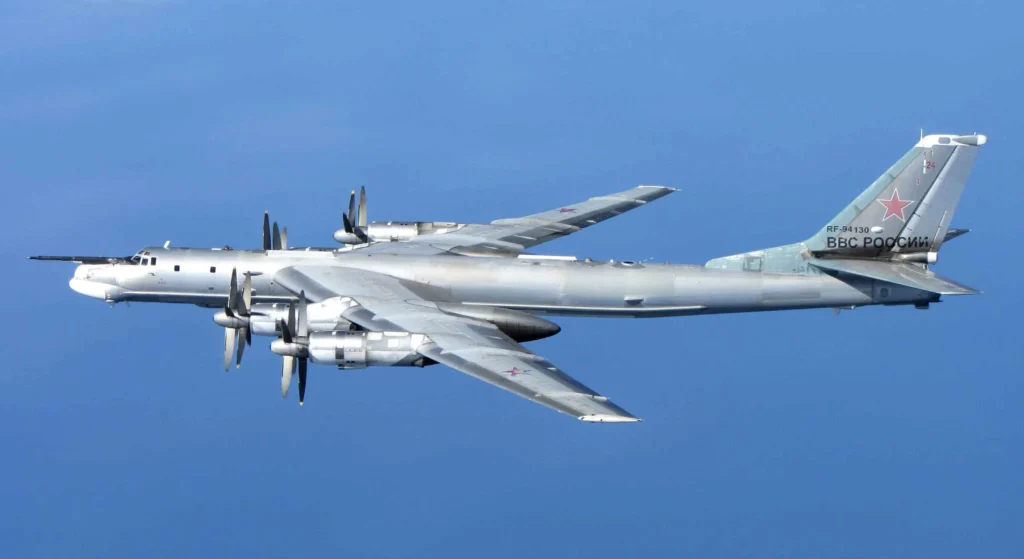
Andrei Tupolev and his design team took on this challenging task. Inspired by the success of American bombers like the B-29 Superfortress, the Soviet engineers developed the Tu-95, which would become the backbone of their strategic air force for decades.
The development of the Tu-95 saw several important milestones, from concept to the first operational flight:
The Tupolev Tu 95 is a massive aircraft, reflecting its role as a long-range strategic bomber. Here are some key dimensions and weight specifications:
| Specification | Details |
| Length | 46.2 meters (151 feet 7 inches) |
| Wingspan | 50.1 meters (164 feet 5 inches) |
| Height | 12.1 meters (39 feet 8 inches) |
| Maximum Takeoff Weight | 185,000 kg (407,855 lbs) |
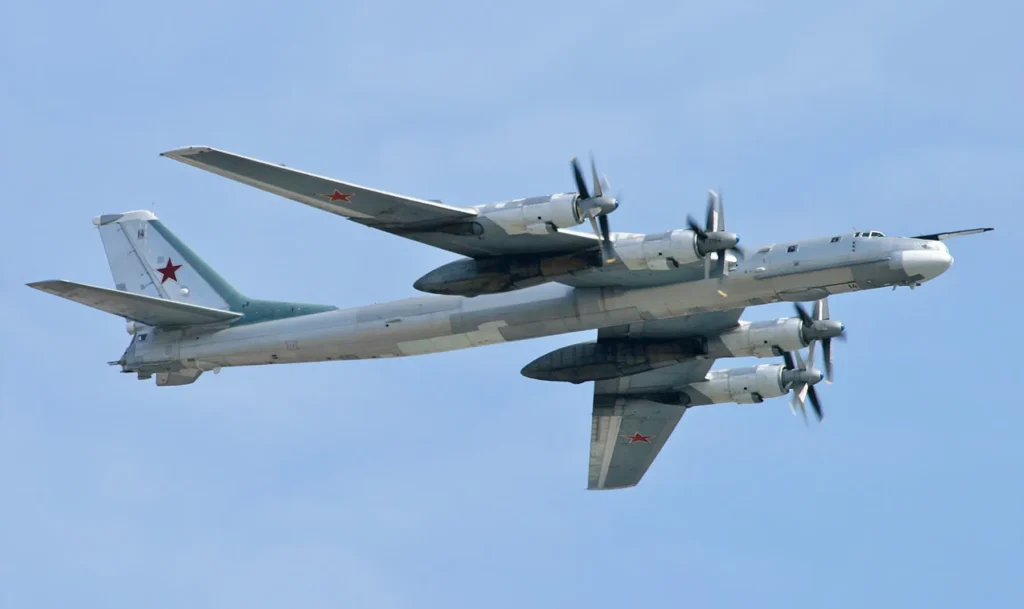
These dimensions make the Tupolev Tu-95 Bomber one of the largest bombers ever built, emphasizing its capability to carry heavy payloads over long distances. When comparing the Tu-95 vs B-52 in size, they are relatively similar, but the Tu-95 stands out with its unique propeller-driven design.
One of the most distinctive features of the Tupolev Tu 95 Bear is its propulsion system. The aircraft is powered by Kuznetsov NK-12 turboprop engines, which are the most powerful turboprop engines ever built. Each engine has two contra-rotating propellers, which are responsible for the plane’s distinctive appearance and unmistakable sound.
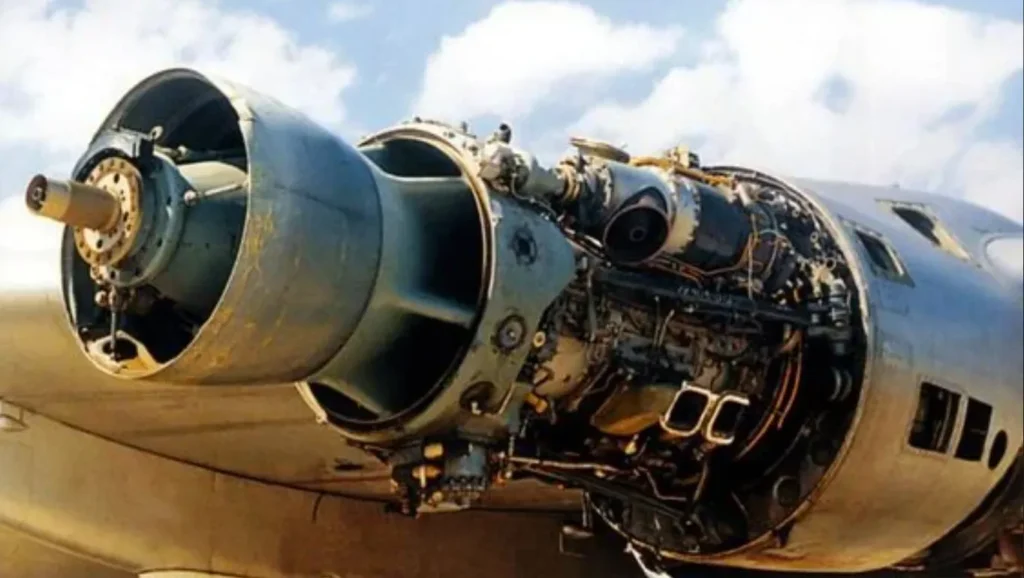
The Tu-95 Bear’s engines provide it with a cruising speed of around 710 km/h (440 mph) and a maximum speed of 925 km/h (575 mph). Despite being a turboprop aircraft, the Tupolev Tu-95 Bomber is capable of reaching significant speeds, which contributed to its effectiveness during the Cold War.
Did You Know? The Tu-95 noise is so loud that the aircraft has earned a reputation among both its pilots and adversaries. The unique sound, generated by the contra-rotating propellers, can be heard from a great distance, leading to the nickname “Russian Bear” among Western pilots.
The Tupolev Tu 95 bomber was originally designed to carry heavy nuclear bombs, but over the years, it has been equipped with a variety of weapons. Here’s a look at its primary payload capabilities:
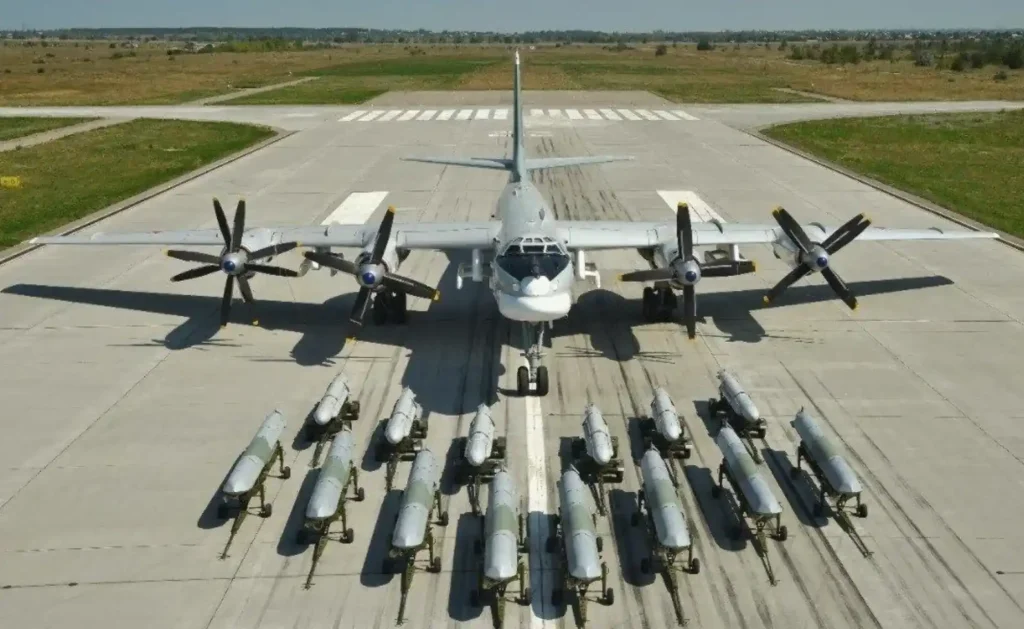
The Tu-95MS variant, often referred to as the Russian Tu-95 Bear-H Bomber, is the most modern version in active service. It primarily functions as a strategic missile carrier, capable of deploying long-range cruise missiles.
The Tu-95 bear cockpit is a classic example of Soviet-era design, characterized by its utilitarian layout and instrumentation. It’s divided into several compartments to accommodate the crew members:
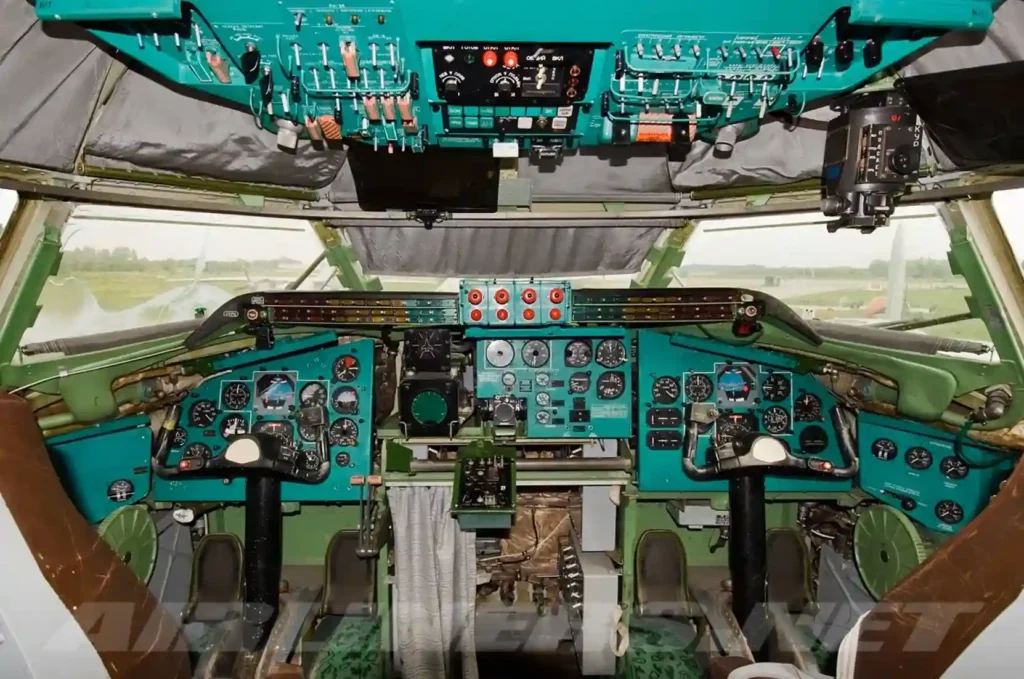
While the Tu 95 cockpit might seem cramped by modern standards, it’s designed to ensure efficiency during long-duration flights. The navigator and radio operator are essential roles, especially for navigating across vast distances and ensuring communication with ground stations.
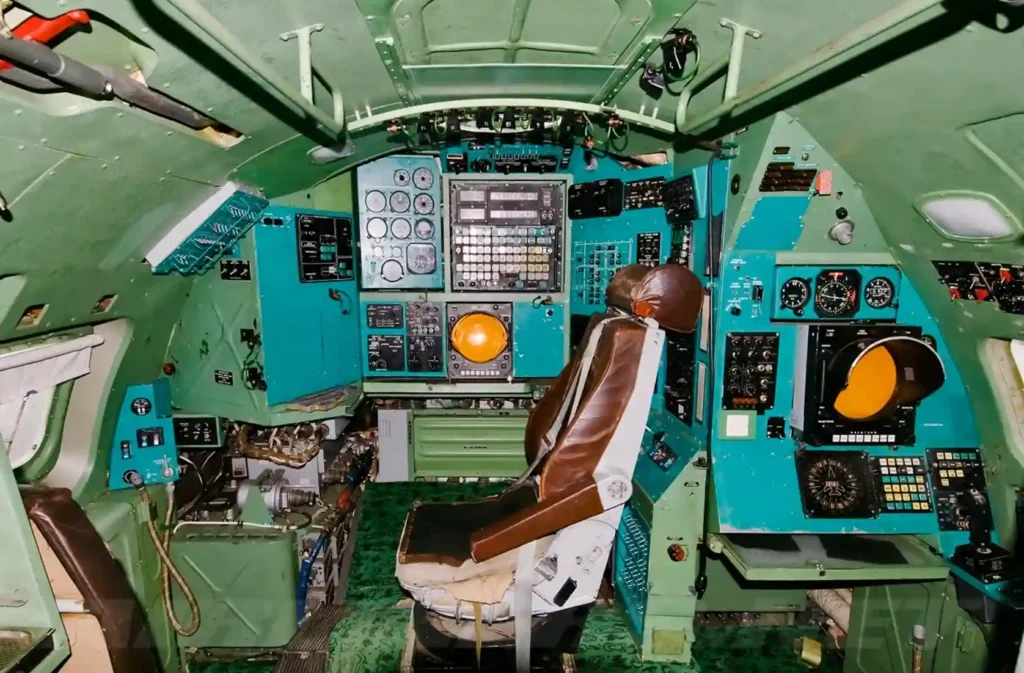
The Tupolev Tu 95 bomber has been produced in several variants over the years, each designed for specific missions and roles. While all versions maintain the core design of the Tupolev Tu-95 bomber, there are key differences between them. Here are the most notable variants:
The Tupolev Tu-95 Bomber has undergone significant modernization over its service life. The most recent upgrades have primarily focused on improving its avionics, navigation systems, and armament capabilities. Key modernization efforts include:
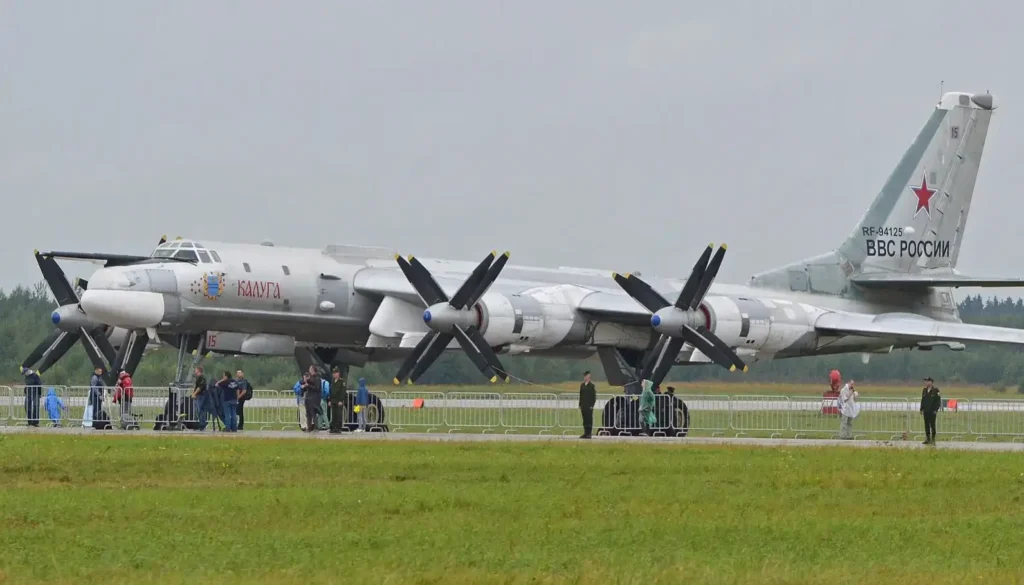
These modernization programs aim to keep the Tu-95 relevant in modern warfare, enabling it to perform strategic missions in a rapidly changing geopolitical environment.
During the Cold War, the Tu-95 Bear Bombers played a pivotal role in the Soviet Union’s strategic air force. These bombers were part of a broader effort to maintain a credible nuclear deterrent against NATO forces. The Tupolev Tu-95 bomber was designed to carry nuclear bombs and, later on, air-launched cruise missiles, providing the Soviet Union with the capability to strike targets across Europe, North America, and Asia.
The Tu-95 was not just a showpiece; it actively participated in missions that tested the limits of Soviet long-range aviation. Some notable operations include:
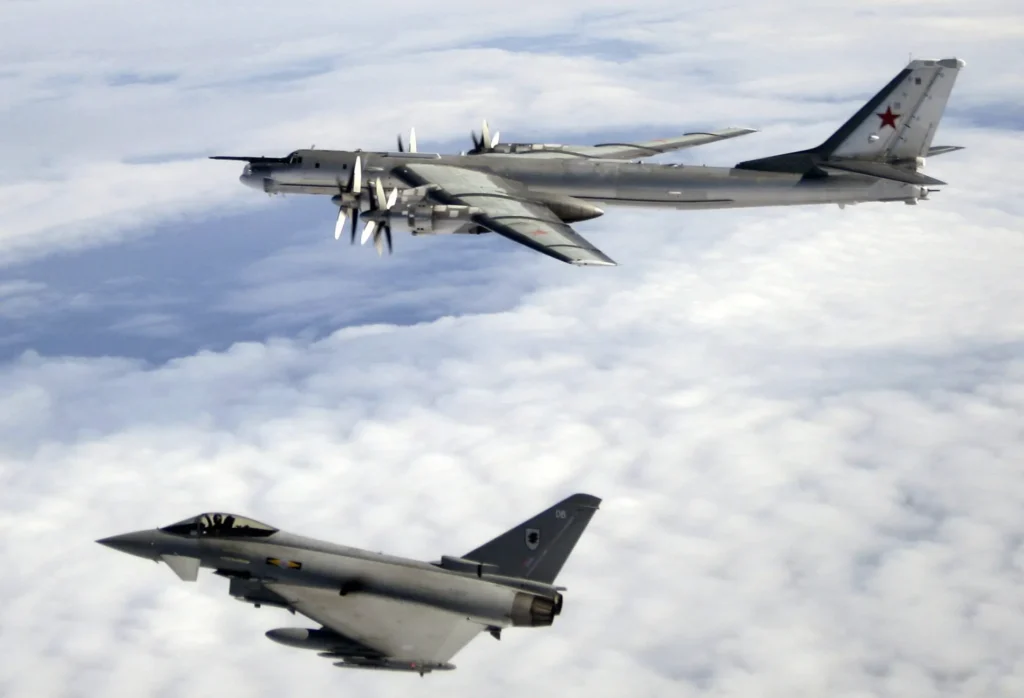
Despite its age, the Tupolev Tu-95 bomber continues to be a mainstay of the Russian Air Force. The modernized variants, like the Tu-95MSM, have been equipped with improved avionics and are capable of carrying advanced cruise missiles, making them relevant in contemporary warfare. Today, the Tu-95 Bear Bombers are often used in strategic missions and exercises, both within Russian airspace and beyond.
In recent years, the Russian Tu-95 Bear Bombers have been seen conducting long-range patrols near NATO airspace. These missions are designed to test the readiness of NATO forces and assert Russia’s strategic presence. For instance:
China released footage of Chinese H-6 and Russian Tu-95 Bear strategic bomber joint "Freedom of Navigation Patrol" in international airspace near Alaska.
— Carl Zha (@CarlZha) July 26, 2024
H-6 and Tu-95 Bear are designed to deliver nuclear weapons pic.twitter.com/w2H4MkMqUk
The Tu-95 Bear has had a significant impact on global military aviation and is seen as a symbol of Soviet and, later, Russian airpower. Its unique design, long-range capabilities, and distinctive engine sound have made it a recognizable figure in military history. When comparing the Tu 95 vs B 52, many analysts highlight the Tu-95’s propeller-driven engines, which contrast sharply with the B-52’s jet engines, making the Tupolev Tu-95 bomber a symbol of Soviet engineering ingenuity.
The Tupolev Tu 95 and the B-52 Stratofortress are two iconic long-range bombers that have been in service since the Cold War era. Despite being designed by opposing superpowers—the Soviet Union and the United States—both aircraft share a similar purpose: strategic nuclear deterrence. However, their designs, capabilities, and roles have distinct differences.
When comparing the Tu 95 vs B52 in terms of size, here are the key dimensions and weights:
| Specification | Tu-95 Bear | B-52 Stratofortress |
| Length | 46.2 meters (151 feet 7 inches) | 48.5 meters (159 feet 4 inches) |
| Wingspan | 50.1 meters (164 feet 5 inches) | 56.4 meters (185 feet) |
| Height | 12.1 meters (39 feet 8 inches) | 12.4 meters (40 feet 8 inches) |
| Maximum Takeoff Weight | 185,000 kg (407,855 lbs) | 220,000 kg (488,000 lbs) |
While both aircraft are quite similar in size, the B-52 has a larger wingspan and a higher maximum takeoff weight, allowing it to carry heavier payloads. On the other hand, the Tu-95’s distinctive propeller-driven design sets it apart, with its four massive turboprop engines giving it a unique appearance and sound.
When it comes to performance, the Tu-95 and the B-52 differ significantly due to their propulsion systems:
In terms of armament, the Tu-95 has adapted over time to carry a variety of weapons, including long-range cruise missiles. The modern Tu-95MS variant is capable of deploying the KH-101/102 cruise missiles, making it a potent threat even in today’s strategic environment. The B-52, on the other hand, is highly versatile and can carry a mix of conventional and nuclear ordnance, including AGM-86B ALCM cruise missiles and JDAM bombs.
During the Cold War, both the Tu-95 bear and B-52 served as crucial components of their respective countries’ nuclear triads. They were designed to fly long-range missions and deliver nuclear weapons deep into enemy territory. However, their roles have evolved in the post-Cold War era.
The comparison between the Tu-95 Bear and the B-52 highlights the unique design philosophies and strategies of their respective countries. The Tu-95’s iconic turboprop engines and focus on long-range capabilities made it a key component of Soviet and Russian strategic forces, while the B-52 became the backbone of the U.S. Air Force’s strategic bombing capabilities with its flexibility and adaptability.
One of the most defining characteristics of the Tupolev Tu-95 bomber is its unmistakable engine noise. Unlike most military aircraft, which rely on jet engines, the Tupolev Tu-95 Bear bomber is powered by turboprop engines with a unique propeller configuration. This design choice has given the Tu95 Bear its legendary, almost thunderous sound, earning it a reputation among aviation enthusiasts and military personnel alike.
The key to the Tu-95’s noise lies in its Kuznetsov NK-12 engines. Each engine features a set of contra-rotating propellers, which means that two sets of propellers spin in opposite directions. This design was chosen to maximize the engine’s power output while maintaining fuel efficiency. However, this configuration also resulted in one of the loudest aircraft in military history.
sight and sound of the Tu-95's NK-12 engines pic.twitter.com/8sbJrWfD4L
— PAVE_naught (@PAVE_naught) March 23, 2023
Here’s why the Tu-95’s engine design creates such a distinctive noise:
The Tu-95 Bear’s noise is so loud that it has become a tactical factor in military operations. Here are some ways that the Tu 95 sound has influenced its operational role:
Interesting Fact: The Tu-95’s noise is often described as a “rumbling growl” or “mechanical thunder” by those who have encountered it in flight. This unique sound, combined with the Tu-95 Bear’s massive size, adds to its reputation as a powerful and iconic bomber.
Over the years, engineers have made several attempts to reduce the noise levels of the Tu-95’s engines. Some of these efforts include:
While these efforts have helped in reducing noise to some extent, the Tu-95 continues to be one of the loudest aircraft in operation, a factor that contributes to its enduring legend.
The Tupolev Tu 95 is a fascinating aircraft with a rich history, unique design, and enduring significance. In this section, we’ll address some of the most commonly asked questions about the Tu 95 Bear Bomber.
The Tupolev Tu-95 bomber can reach a maximum speed of 925 km/h (575 mph), making it relatively fast for a turboprop-driven aircraft. While not as fast as jet-powered bombers like the B-52, the Tu-95’s cruising speed of around 710 km/h (440 mph) is impressive given its size and the technology available at the time of its development. The focus of the Tu-95 was always more on long-range capability and endurance than on outright speed.
The Tu-95 cockpit is designed with functionality and efficiency in mind. It has a utilitarian layout typical of Soviet-era aircraft, with essential controls and instrumentation arranged for optimal crew coordination. The cockpit is divided into multiple compartments for different crew members, such as the pilot, co-pilot, navigator, and radio operator. It’s not known for comfort, as noise and vibrations from the engines are a constant challenge, but it’s designed for long-duration missions.
The Tu-95’s Kuznetsov NK-12 engines are the most powerful turboprop engines ever built. The engines feature contra-rotating propellers, which allow them to generate more thrust and maintain high efficiency. This design, while noisy, provides excellent range and fuel economy, making the Russian bear bomber tu-95 a practical long-range bomber for the Soviet Union and later Russia.
The Tu-95 has an operational range of around 15,000 kilometers (9,321 miles) without refueling. This long-range capability allows the Tu-95 to conduct strategic missions over vast distances, making it ideal for patrolling international airspace or reaching key targets without needing to rely heavily on refueling operations.
When comparing the Tu 95 vs B 52, several differences stand out:
For a more in-depth comparison, check out the detailed section on Tu 95 bear vs B 52.
The Tupolev Tu-95 Bomber, often called the Tu-95 Bear, is much more than just a military aircraft. It’s a symbol of Soviet engineering ingenuity and Cold War history. Developed during a time of heightened global tensions, the Tu-95 quickly became one of the cornerstones of the Soviet Union’s strategic air force, and its legacy continues to this day with the Russian Air Force.
The Tupolev Tu-95 bomber is unique in its design, with its iconic contra-rotating propellers and powerful NK-12 engines that contribute to its distinctive sound. Over the decades, the aircraft has gone through numerous upgrades and variants, adapting to new technologies and evolving military needs. Despite being over six decades old, the Russian Tu 95 Bear Bombers continue to play an important role in Russia’s long-range strategic operations.
From its origins in the 1950s to its modern Tu-95MSM variant, the Tu 95 bears has served as a symbol of power, resilience, and strategic capability. It has been involved in countless patrols, interceptions, and reconnaissance missions, making it an enduring feature of military aviation history.
While newer bombers with advanced stealth and technology are being developed, the Tu 95 Bear continues to prove its worth. For now, the Russian Tu-95 Bear Bombers remain a significant part of the nation’s strategic capabilities. Their distinctive noise, long-range endurance, and historical significance have cemented the Tu-95 in the annals of aviation history.
Thank you for taking this journey through the history, design, and enduring legacy of the Tupolev Tu-95 Bomber. I hope this comprehensive guide has answered your questions and given you a deeper understanding of this iconic aircraft.
Share
Defense Feeds is publication focusing on informing, engaging, and empowering the world by providing accurate information from defense technology.
Powered by Defense Feeds © 2025 – All rights reserved.